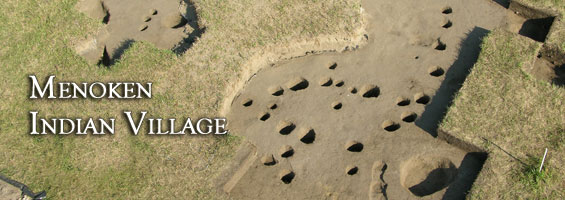
Menoken Village was a small community consisting of approximately 30 oval-shaped, earth-covered houses and a prominent fortification system. Once thought to have been a Mandan Village occupied at the time of early contact with Euroamericans, Menoken Village has recently been radiocarbon dated to around AD 1200. Archaeological studies indicate that this settlement was built and used by Late Plains Woodland peoples, who were primarily hunters and gatherers rather than farming people. The community may have consisted of 200 individuals.
Menoken Village is earlier than any settlement that can be linked with certainty to Mandan, Hidatsa, or Arikara peoples in North Dakota. However, the people who occupied Menoken Village were probably the ancestors of at least some of these historic village tribes.
This location was carefully chosen for its defensive features. The steep banks to the north and west would be difficult for intruders to climb. The rest of the village was protected by a tall wall, or palisade, and the deep ditch we can still see today. The fortification ditch was dug just outside the palisade, enclosing almost one and one-half acres. The construction of the fortification system required organized labor and much timber. As the map shows, the ditch formed a long arc, interrupted by four projecting loops, or bastions.
Menoken Village was designated a National Historic Landmark in 1964, largely because of the supposed connection to some of the earliest European explorations. Today we know Menoken Village is much older, but still a very significant cultural landmark.
Address:
171st Street Northeast
Menoken, ND 58558
Get Directions
Hours:
Open year round.
Contact Us:
phone: 701.328.2666
email: history@nd.gov